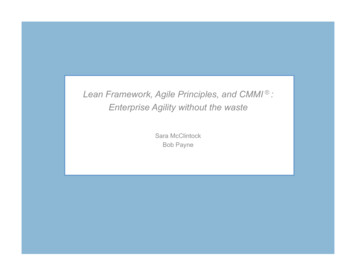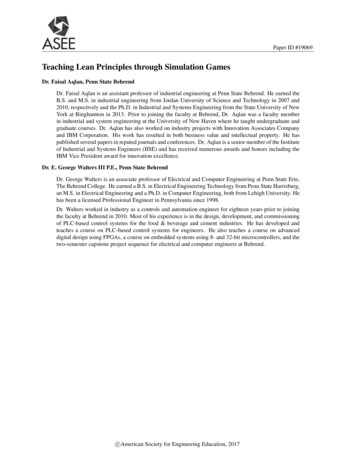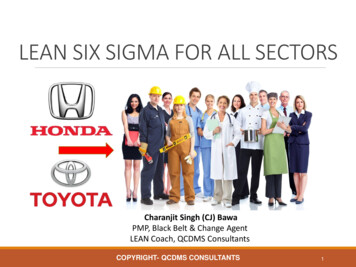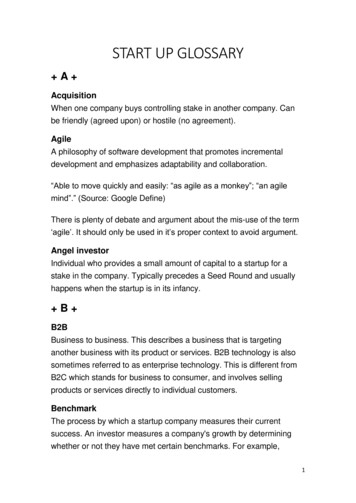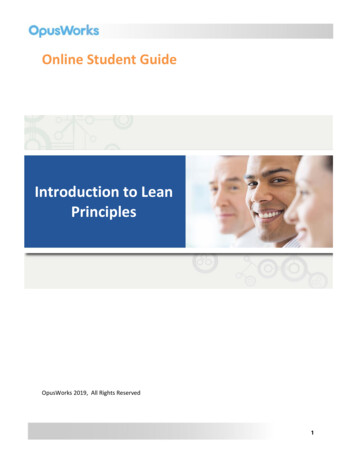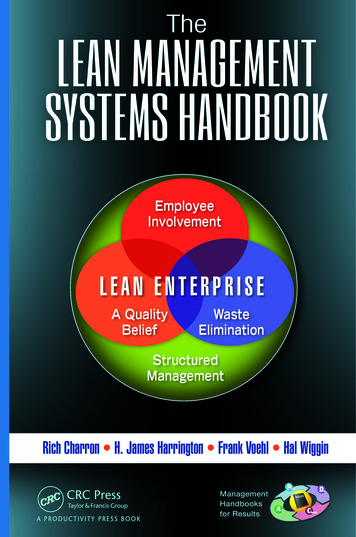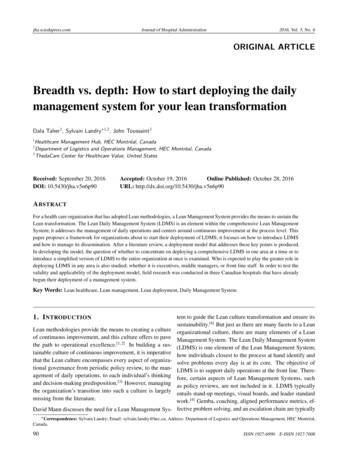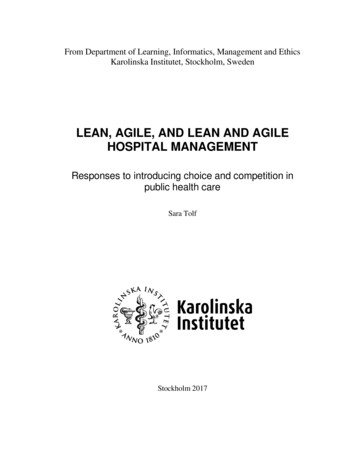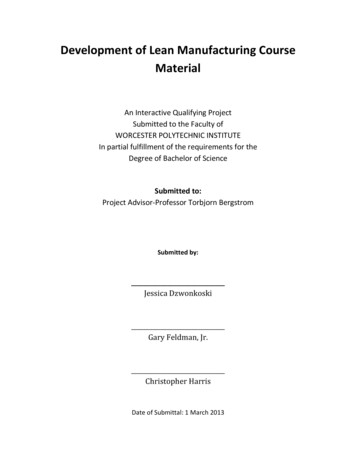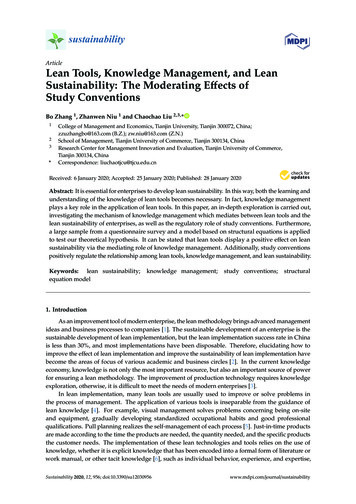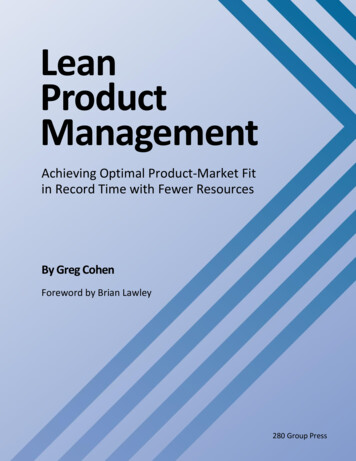
Transcription
LeanProductManagementAchieving Optimal Product-Market Fitin Record Time with Fewer ResourcesBy Greg CohenForeword by Brian Lawley280 Group Press
Copyright 2011 by Greg CohenAll rights reserved. No patent liability is assumed with respect to the use of the information contained herein.Although every precaution has been taken in the preparation of this book, the publisher and author assume noresponsibility for errors or omissions. Neither is any liability assumed for damage resulting from the use of theinformation contained herein.First Edition: September 2011 (v201304011-ARc)eBook ISBN: 978-1-60005-216-3Place of Publication: Silicon Valley, California, USATrademarksAll terms mentioned in this book that are known to be trademarks or service marks have been appropriatelycapitalized. 280 Group Press cannot attest to the accuracy of this information. Use of a term in this book shouldnot be regarded as affecting the validity of any trademark or service marks.Warning and DisclaimerEvery effort has been made to make this book as complete and as accurate as possible, but no warranty of fitnessis implied. The information provided is on an “as is” basis. The authors and the publisher shall neither liability norresponsibility to any person or entity with respect to any loss or damages arising from the information contained inthis book.i
ContentsForeword .1Preface .2The Need for an Alternative Product Management Framework .4Intended Audience . 4SECTION 1INTRODUCTION TO LEAN PRODUCT MANAGEMENT .6Lean Product Management Defined .6The Role of the Lean Product Manager . 6Mathematical Definition . 7Fit . 8The Foundation of Lean Product Management. 11The Theory behind Lean Product Management . 11Principles of Lean Product Management . 16SECTION 2THE PRODUCT-MARKET FIT CHALLENGE. 19Models . 19Understanding the Product–Market Fit Challenge . 19Case Studies . 22Optimizing (Type I) . 23Market Driven (Type II) . 24Tech Driven (Type III) . 26Visionary (Type IV) . 28Matching the Discovery and Development Processes to the Product-Market Fit Challenge . 31Problem, Product, and Business Model Defined . 31ii
Problem Undefined . 31Product Solution Undefined . 32Business Model Undefined . 34Two or More Vertices Undefined . 36Validated Learning . 36Key Product Discovery and Business Model Questions . 39Project . 39Problem . 39Product . 40Business Model. 42Piecing It All Together . 43SECTION 3BECOMING LEAN. 44Practices . 44Skills and Knowledge Areas . 48Measures. 49Pay-Off and Risk. 51Portfolio Planning and the Ideation Funnel . 52Implications to phase gate . 53Implications for project funding . 54Leaks versus Launches. 55Process Improvement . 56Where Do Services Fit?. 56Conclusion . 57Advancing the Discussion . 57iii
Acknowledgements. 58About the Author . 59About 280 Group . 59Other Books by the 280 Group . 60iv
FiguresFigure 1: Mathematical expression of Lean Product Management . 7Figure 2: The five-step Lean Thought Process . 12Figure 3: Working in smaller batches significantly reduces delivery time . 13Figure 4: By sequencing projects, we can deliver value sooner and commit later . 14Figure 5: Total differentiation is a function of time . 16Figure 6: The goal is to maximize the area under the curve, which represents the differentiation of ourproduct over time . 17Figure 7: Product-market fit triad . 20Figure 8: Problem-Product Solution Matrix illustrating the four product solution types . 21Figure 9: Problem, product, and business model combine to yield eight different product-market fitchallenges . 22Figure 10: Flip created a new camcorder segment by focusing on under-served needs and cutting backon over served needs . 25Figure 11: Google Adwords report for “video watch” shows an astounding one million monthly searchesas well as hints at some of the intended uses. For reference, Rolex receives just over four million . 33Figure 12: Business Model Canvas. 34Figure 13: Producing validated learning requires many cycles to converge on a viable product-market fit.It also requires some resets when a hypothesis turns out to be false. During those times, we cyclecounterclockwise. . 37Figure 14: Ansoff’s Product Growth Matrix. The matrix is in terms of your company. Thus, entering anew market means entering a new market for the company. The market may be established with othercompanies serving its needs. . 41Figure 15: Olsen Design Maturity model defines four levels organizational capability . 44Figure 16: Example portfolio view of current projects based on differentiation, level of uncertainty, andtime horizon . 52Figure 17: Start-ups that made a significant change to their original business plan succeeded more oftenthan companies that stuck to their original business plan . 53v
Figure 18: Traditional serial product lifecycle is ordered by activity. In contrast the concurrent productlifecycle needed for the many product-market fit challenges in which the problem, solution or businessmodel are not fully defined is phased by learning objectives. . 55vi
ForewordOver the past twenty years Product Management has matured and become recognized as a profession.The need for a strong product management function, process and staff as a critical component fordelivering excellent products with high profitability has never been more fully recognized oracknowledged than it is now. Great companies invest in building great product management, and theresult is that they reap the rewards of customer loyalty and profitability.Along with the changes in terms of visibility and recognition there have also been many advances inProduct Management methodology and resources. Product Management Associations, ProductCamp(Pcamp) conferences, books, best-practices templates, frameworks, white papers and many otherresources have been brought to life.The 280 Group itself has contributed a large amount to the efforts of moving Product Managementforward. Our 280 Group Press series of books, Optimal Product Process consulting and trainingofferings, newsletter and blog, Product Management LifeCycle Toolkit and Product ManagementOffice and our vast array of free resources and white papers have helped tens of thousands ofcompanies to implement better product management.Twenty-five years ago when I began my product management career none of these resources existed.Indeed, things have come a long way. But as with anything, there is always a need to push the envelopeand see what can be done to break free from the past and move forward into an exciting and morefruitful future.Thus we present to you this book. It is designed to challenge your thinking about how ProductManagement has “always been done.” In fact, it is designed to challenge the 280 Group’s own thinkingabout best practices and the methodology that we train and help companies to implement.It is possible that the theories put forth in this book will have limited applicability. It is also quite possible(and in my mind highly likely) that for many companies and teams there is a need to do things verydifferently than the Product Management history and tradition would allow for.So please enjoy this book. Be highly critical. Challenge our assumptions. Be vocal. Participate. Work withus to discover new and better ways to great Product Management.We welcome your feedback and opinions!Brian LawleyCEO and Founder, 280 Group1
PrefaceThe dot com era was an exciting time for me. I had left the relatively stable world of medical devicesand diagnostics on the East Coast, and headed to Silicon Valley to join the Internet boom as a softwareproduct manager for the e-commerce platform provider Pandesic. Intel and SAP had provided generousfunding for the company and the organization had grown to over 400 people. The company had plentyof cash and lots of brains, with many employees coming out of Intel, Visa, and SAP. My Pandesiccolleagues might very well have been the most talented group of individuals with whom I have everworked. But we had a problem: our customers were learning how to sell products through the internetand our traditional product development techniques couldn’t keep pace with the needs of a rapidlychanging market.In one year, I was recruited out of Pandesic to join an idealab! Incubator company. Although I didn’trealize it at the time, this was to be my most profound experience in product management. We had atiny team with no formal business plan - just a charter to see how far we could take an idea thatideaLab! had dreamed-up and short term milestones to ensure we were making progress. We used theLAMP open source stack (Linux, Apache, MySQL, and PHP). Our development team never exceededseven members. We launched the product within two months, which was unheard of in those days. Atfirst we worked on five-week release cycles, which we soon compressed to three weeks when weadopted XP (Extreme Programming.)We studied how users behaved on our system (you need to realize this was 2001, and we had very crudemetrics at best). We zigged and zagged with each new piece of information. We were nimble, and itwas an amazing rush to work in this type of environment. Unfortunately for us, the dot com bubbleimploded and capital dried up. Although we had exceeded all our commitments to the board, we werestill far from profitability. Most of our customers were dot com businesses who were also struggling forsurvival, which meant our timeline to breakeven was rapidly growing longer. Before long, ideaLab! madethe only reasonable choice, which was to shut us down and focus their shrinking resources on a smallerset of projects that were likely to yield quick results.After my time at ideaLab! I never looked at the world the same way again. It wasn’t until years later,after further study of Agile development, Lean concepts, and Steve Blank’s “Four Steps to Epiphany”,that I fully grasped why our small team at ideaLab! accomplished so much in such a short time with sofew resources. In this guide, I’ll refer to concepts like validated learning. At ideaLab! we called that“throw it against the wall to see if it sticks.”1 Further, when we changed our business plan as a logicaloutcome of what we learned that day, we didn’t call it a “pivot.” It’s just what we did – it didn’t have a1One way to tell if spaghetti is properly cooked is to throw it against the wall. If it sticks, it is ready to eat. If it fallsoff, it needs to cook longer.2
specific name. Fortunately, there is now a language to describe these techniques that ideaLab!experimented with in the days of Web 1.0. They became more widely adopted during the Web 2.0boom, and are now being popularized and further developed through the Lean Start-up movement. Thecodification and evolution of these practices is a major step forward.The implications of this little slice of history are now clear. The choices we have when we build producthave changed, and product managers need to understand the new rules to know when it is beneficial and even necessary - to apply new methods. Further, best practices only exist at a point in time.Product teams have and will continue to identify better practices, and product management as adiscipline will continue to evolve.In this guide, I intend to lay out an alternate framework for product management. The frameworkaccommodates the uncertain nature of new product development, the different contexts in newproduct development, and continually improving the practice of product management.I hope you enjoy reading this guide as much I enjoyed writing it.3
The Need for an Alternative Product Management FrameworkThe product manager’s role is now recognized as critical within technology companies. Yet we stillpractice our trade as a craft rather than as a management science. Further, the profession has beenslow to leverage and understand the full impact of changes in process and technologies that canradically improve the speed and effectiveness with which we cancreate products that customers love, and which are differentiatedfrom the competitive alternatives. As competitive pressures andthe rate of technological increase, effective product management“We get brilliant results fromaverage people managingbecomes a necessity. The margins between product success andbrilliant systems. Our competitorsfailure continue to narrow.get average results from brilliantpeople working around brokenThis guide seeks to examine Lean principles and how they applysystems.”to the field of product management. Furthermore, it seeks toprovide a framework for continuous improvement and self- Fujio Cho, Toyota chairmanreflection, so that product management as a discipline can movefrom craftsmanship to management science – a process that canprovide companies with sustained competitive advantage.Intended AudienceAlthough the principles in this guide are universal, it is written for technology companies and individualsleading product management teams and organizations. Much of the discussion centers on softwaredevelopment, with a further focus on hosted products that have user interfaces. Software - especiallyhosted web services - offers a flexible medium in which to work. There are three characteristics ofhosted software that are particularly attractive to product managers: Updates require minimal cost and time to deploy into the marketplace. Because the transactioncost for the updating is so low, it is feasible to make frequent improvements to the product.The product can be instrumented to provide a rich set of analytic data, which gives the productmanager great insight into how the product is being used, what features are being used, and thefrequency of use. This usage data can be captured quickly, continually, and at low cost.4
Design and development (i.e. manufacturing) largely happen in tandem, which allows designdecisions to be locked down late in the development cycle. Many design decisions can be changedwith minimal cost. This is different from a manufactured good where the design must be finalizedto create the tooling,2 and changes can be expensive. Of course, 3-D printing may lessen thisconstraint.So the application of the methods discussed will need to be adjusted to address the individualconstraints of the company culture (which may itself need to change), the product medium and themarket environment. Specifically, some adjustment is recommended for physical goods, client installedsoftware, mission critical products, or regulated products to accommodate the increased time and costof each iteration in the learning cycle.Lastly, this guide is intended to challenge conventional thinking: as always, apply common sense.2Japanese automakers have developed some work-arounds for this constraint. They rough-cut dies for stampingbody parts early in the process, as the design is evolving and leave excess material where they believe changesmight still occur. The final design is not locked down until late in the process, leading to better die designs, andfaster time to market. (source: Mary and Tom Poppendieck, Lean Software Development: An Agile Toolkit, Boston:Addison Wesley, 2003) p. 48.5
1Introduction to Lean ProductManagementLean Product Management DefinedThe subtitle of this guide is:Achieving optimal product-market fit in record time with fewer resourcesAlthough that captures the essence of Lean Product Management - it's better, faster, and cheaper. If wewanted to be even more precise, we could expand it a little:Achieving ever better product-market fit in ever less time with ever fewer resources3Although this second definition is less snappy, it makes the point that Lean Product Management is ajourney. It is a process of continuous learning and improvement. There is no point at which we can say,“We have arrived.” We can only say, “We did better today than yesterday, and I believe with thefollowing changes we can do even better tomorrow.”The Role of the Lean Product ManagerProduct Managers bridge the problem and solution spaces. In the problem space, the product managerworks to uncover customer problems, identify those that the customer is willing to pay to solve, andthen confirms that there are enough customers who share the problem to constitute a market.In the solution space, the product manager works with designers, user experience experts, andengineers to explore possible solutions to the problem. The goal is to find a solution that is technicallyfeasible and can be: Produced at a cost well below the price the customer is willing to payDelivered and serviced through a distribution channel that can reach the target market costeffectivelyDifferentiated from the competitive alternatives3James P. Womack, author of Lean Thinking defines Lean as “Creating ever more value for customers with everfewer resources.” Dan Olsen adapted the definition to product management in his Silicon Valley P-camp 2011 talk“Lean Product Management” (http://www.slideshare.net/dan o) as “Achieving Product-Market Fit quickly in aresource efficient manner” which better captures Lean from the product management perspective.6
Thus, the faster and more cost-effectively the product manager, working with the product team, canachieve product-market fit, the better the absolute and risk-adjusted return on the product – for tworeasons:1. A better fit leads to a more appealing product for the target market2. A faster fit means the product will enjoy maximum differentiation for a longer period of time.As product managers learn new ways to achieve product-market fit faster and with fewer resources,they become more effective, their products more successful, and their companies more profitable. Agreat product manager can create a successful product, and a great product management process canlead to sustainable, long-term competitive advantage for the company.Mathematical DefinitionLean Product Management can be expressed in a simple yet powerful formula (Figure 17):Figure 1: Mathematical expression of Lean Product ManagementThe goal is to perform activities that will increase product-market fit, decrease our time to market, anddecrease our costs. The first half of the equation deals with revenue and the second half with cost. Theexpression is a proxy for Profit Revenue – Cost. A team starts with a given structure, process andcapability, so the formula focuses on changes (or deltas) that might be implemented. Although it wouldbe impossible to accurately quantify every decision, the formula can be used to guide decisions. Forexample:1. By answering a research question, the product will have greater differentiation in the market,leading to a higher price point and increased sales. If the incremental profit from the better fit isgreater than the cost of the research, then the activity should be performed.2. If time to market can be decreased by 30 days with the help of an outside vendor, and the profitduring those 30 days is greater than the costs to accelerate the project, it is worthwhile.3. However, if time to market is reduced by skipping important concept testing that will ultimatelydecrease fit, then this is a bad trade-off and will make the product less profitable. This is knownas the rush to failure.44Jim Reekes, Senior Consultant and Trainer at the 280 Group, introduced me to this term which perfectly captures7
Ideally, the improvement cycle is reinforcing, improving two - or all three - variables together. Forexample, decreasing time to market by increasing collaboration between groups produces revenuesooner and reduces costs, because the product team‘s salaries are now going towards the next projectof value.Lastly, it is important to optimize the whole system and not just a local function. For this reason, theformula looks at time to market and not the time taken for individual steps. For example, if the productmanager pushes user stories to development without good satisfaction criteria, he may have savedhimself time, but the stories will require additional iterations to achieve acceptable fit, lengthening theoverall time to market and to market fit.Interestingly, after version one is released, a company may deliberately want to pace the introduction ofthe next version - either to maximize profits on the product or because the market cannot absorbreleases at a faster pace. In this situation, you should fix “time to market” based on the ideal releasecycle and focus the product team’s efforts on improving fit and decreasing cost during the allocatedtime.FitAchieving and maintaining fit is an incremental process, and therefore needs to be tested repeatedlyfrom concept development through limited availability and post-launch stages. This testing occursthrough a mix of qualitative and quantitative methods.CONCEPT DEVELOPMENT FITDuring concept development, fit is usually measured qualitatively though interviews and focus groups.If the person being interviewed or shown the concept goes out of their way to ask to be notified whenthe product becomes available, that’s a good sign. If you ask them if they’d like to know when theproduct becomes available, assume they are just being polite when if they answer “yes.” If they indicatethey like the idea, it is fair. If they indicate they love it, they probably only like it. 5 What does come outof these concept test interviews are the benefit and feature areas that customers like, are indifferent to,dislike, or have concerns about. This research not only helps guide the product priorities but also themessaging.how product teams can run off at full speed to create a solution before they even truly understand the problemthat needs solving.5Remember to also make allowance for cultural differences. Very broadly, individuals from cultures that deprecatepersonal demonstrativeness (e.g., the UK, Germany) might be more muted in their response than individuals fromthose that place a higher value on positive attitudes (e.g., the US).8
There are advanced methods, such as problem detection studies, that can help rank problems to besolved. Kano surveys can provide insight into which product problems would - if solved - createexcitement from users and, conversely, would create dissatisfaction if not solved. Adaptive conjointanalysis allows companies to test different configurations and prices to understand relative tradeoffsusers will make. These advanced methods: Are expensive.Assume the user is familiar with the product category (not good for visionary products).Assume your implementation of the solution will meet the user’s expectation.In the concept stage, measurement is often based around trying to be directionally correct. F
Lean Product Management Achieving Optimal Product-Market Fit in Record Time with Fewer Resourc
